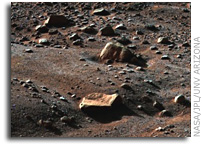NASA Mars Phoenix Camera Sees Morning Frost at the Landing Site

Image: Water frost appears in this image the Phoenix Mars Lander’s Surface Stereo Imager took on Aug. 14, 2008, at 6 a.m. local Mars time on Sol 79, the 79th Martian day after landing. The frost begins to disappear shortly after 6 a.m. as the sun rises on the landing site. The sun was about 22 degrees above the horizon when SSI took the image. Light at that oblique angle enhanced the detail of the polygons, troughs and rocks in the surrounding terrain. The image is false-color, enhanced to bring out details in the terrain. (NASA/JPL-Calech/University of Arizona/Texas A&M University) Water frost around the spacecraft hints that Martian fall is coming soon.
The Surface Stereo Imager, or SSI, on NASA’s Phoenix Mars Lander has seen water frost on the ground around the spacecraft’s landing site.
Water frost appears in an image the SSI took on Aug. 14, 2008, at 6 a.m. local Mars time on Sol 79, the 79th Martian day after landing. The frost begins to disappear shortly after 6 a.m. as the sun rises on the landing site.
The sun was about 22 degrees above the horizon when SSI took the image. Light at that oblique angle enhanced the detail of the polygons, troughs and rocks in the surrounding terrain.
The SSI view was looking east-southeast, so the lander’s eastern solar panel is visible in the bottom lefthand corner of the image. A rock informally named “Qaudlings” appears in the foreground, and another rock, called “Winkies,” is located near the center of the image.
The science team enhanced the false-color image to show color variations. A larger view of the image is featured on the UA Phoenix Mars Mission gallery.
The SSI camera has taken thousands of images from atop its mast on the lander deck since landing day, May 25, 2008. The science team has relied on the camera’s stereo vision to guide them in choosing where to dig and in operating the robotic arm.
A team led by Chris Shinohara of the UA Lunar and Planetary Laboratory built the SSI. Mark Lemmon of Texas A & M University, an alumnus of UA, is lead scientist for the camera.
The Phoenix Mission is led by the University of Arizona on behalf of NASA. Project management of the mission is by NASA’s Jet Propulsion Laboratory, Pasadena, Calif. Spacecraft development is by Lockheed Martin Space Systems, Denver.









